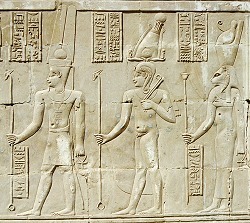
Término utilizado para referirse a un grupo de tres dioses, por lo general organizado en una familia compuesta por un padre, una madre y un hijo. El deseo de que fuera más fácil comprender al dios también tuvo su importancia (en egipcio 'tres' también significa 'plural'). Las tríadas más conocidas eran la de Tebas, formada por Amón, Mut y Jonsu; la de Memphis, formada por Ptah, Sejmet y Nefertum; la de Edfú, formada por Horus, Isis (o Hathor) y Harsomtus; y la de Dendera, formada por Horus, Hathor e Ihi (o Harsomtus). Un tríada típica representa la división más pequeña en tres personas del andrógino dios creador primigenio. Las dos deidades masculinas (por ejemplo, Amón y Jonsu) son dos aspectos de un sólo dios: Amón renace como Jonsu y Jonsu es el joven Amón; Amón es el adulto/anciano Jonsu en el eterno ciclo de muerte y resurrección. El elemento femenino de la tríada no es sólo la esposa (o incluso la 'hija') del dios, sino también la madre del joven dios; debido a que Amón y Jonsu son un único dios, Mut es simultáneamente madre, esposa e hija. A veces, las tríadas ponen un énfasis especial en el elemento femenino, por ejemplo la de Elefantina, formada por Jnum y las diosas Satet y Anuket. Un tipo diferente de tríada está formada por tres dioses, como la tríada del Imperio Nuevo formada por los tres dioses del Estado: Amón, Re y Ptah y sus ciudades: Tebas, Heliópolis y Memphis.